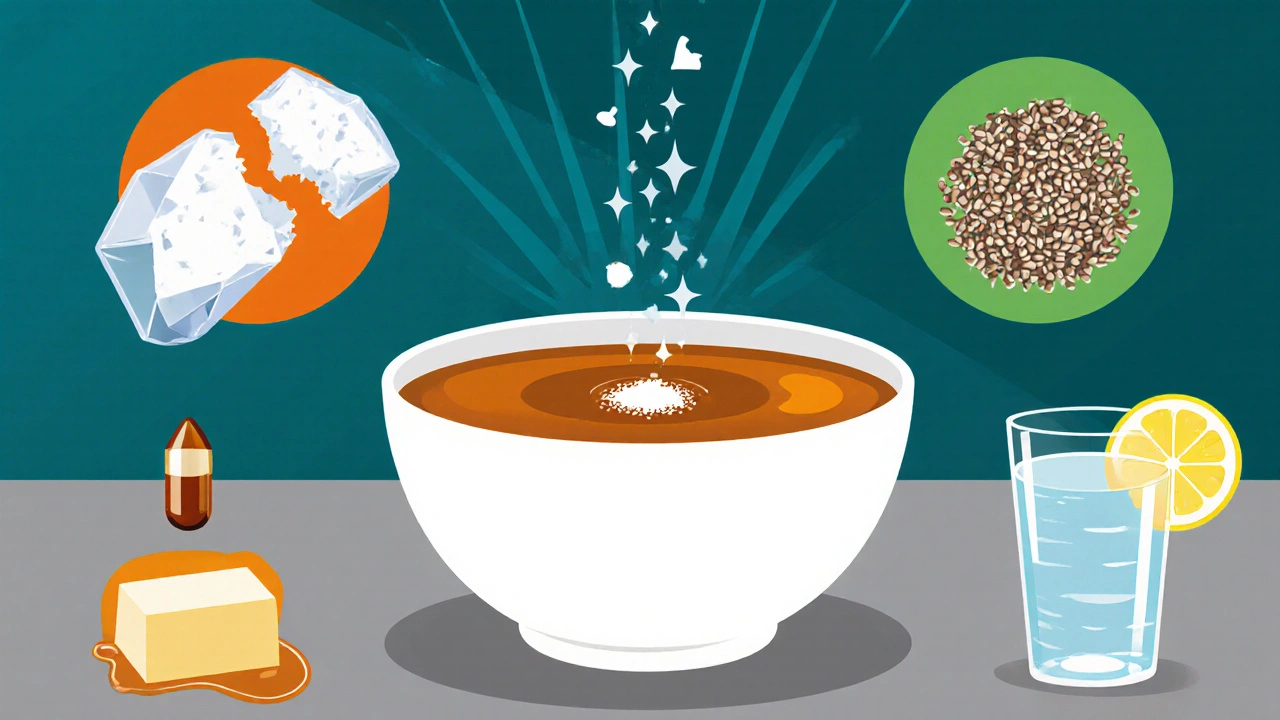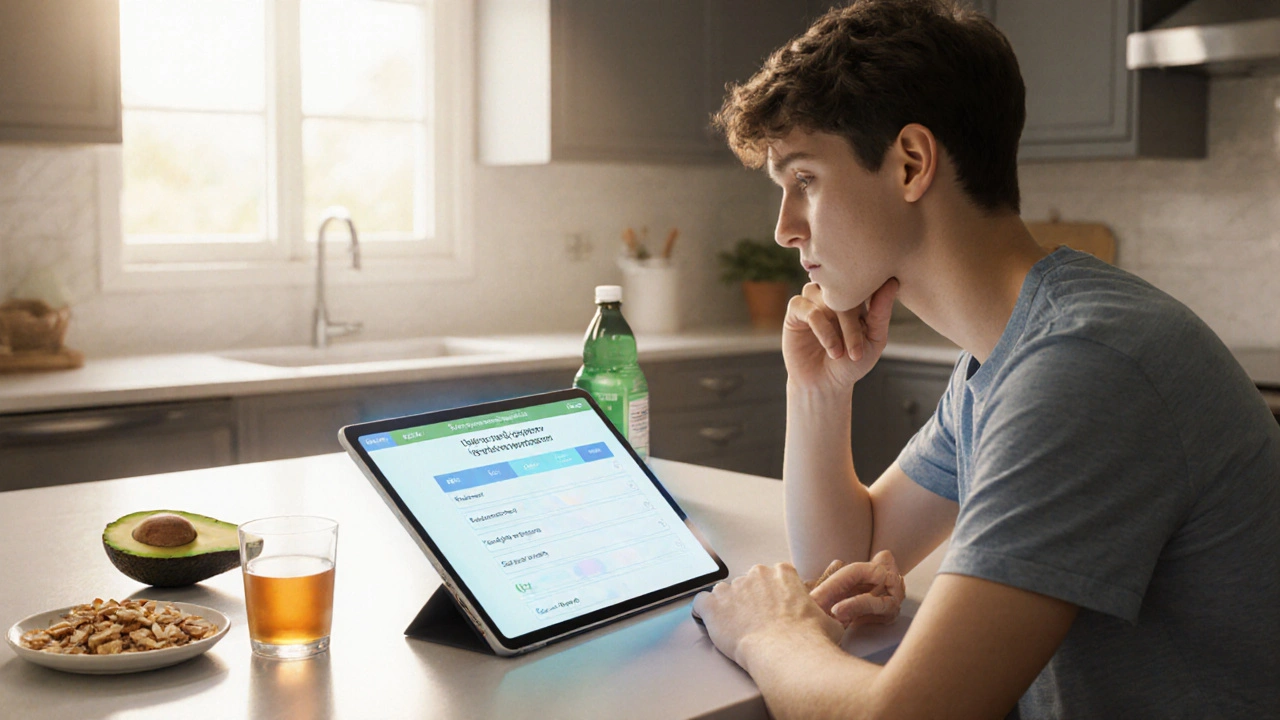Keto Diet Diarrhea Trigger Identifier
Common Triggers & Fixes
Sugar Alcohols
These are poorly absorbed and draw water into the colon.
Fix: Switch to monk fruit or stevia; limit processed keto sweets.
Sudden Fiber Increase
Rapidly fermentable fibers create gas and loose stools.
Fix: Introduce low-FODMAP fiber sources gradually.
Fat Malabsorption
Too much dietary fat overwhelms lipase enzymes.
Fix: Add quality lipase enzyme; start with 15-20g fat per meal.
Electrolyte Depletion
Low sodium/potassium causes watery stools.
Fix: Drink broth or electrolyte-rich drinks; add sea salt to water.
Switching to a low‑carb, high‑fat lifestyle can feel like a breath of fresh air-until the bathroom schedule starts acting up. Many newcomers to the Keto diet a high‑fat, very low‑carb eating plan that pushes the body into a metabolic state called ketosis notice loose stools, cramping, or sudden urgency. If you’re dealing with keto diet diarrhea, you’re not alone, and you don’t have to quit the diet. Below are practical, science‑backed tips to calm your gut while staying in ketosis.
Quick Takeaways
- Hydrate with electrolytes (sodium, potassium, magnesium) before you reach the toilet.
- Identify common trigger foods-sugar alcohols, sudden fiber spikes, and excess fat.
- Add probiotic‑rich foods or a quality supplement to rebalance gut bacteria.
- Introduce digestive enzymes (especially lipase) if you suspect fat malabsorption.
- Gradually increase carbs back to 20‑30g if symptoms persist, then re‑enter keto with a slower transition.
What Is Diarrhea the frequent passage of loose, watery stools that can lead to dehydration and electrolyte loss?
Diarrhea isn’t just a nuisance; it strips the body of water and vital minerals in minutes. For keto followers, the rapid loss of sodium, potassium, and magnesium can knock you out of ketosis, trigger headaches, and make you feel shaky. Understanding why it happens is the first step toward fixing it.
Why the Keto Shift Can Upset Your Gut
When you cut carbs below 5% of daily calories, your body swaps glucose for ketones as fuel. This metabolic pivot, called ketosis a state where blood ketone levels rise because carbohydrate intake is very low, brings several gut‑related side effects:
- Reduced intake of fermentable fibers that normally feed friendly bacteria.
- Higher reliance on fat, which can overwhelm the digestive system if enzymes are insufficient.
- Changes in water balance because carbs store water; losing carbs means you lose water fast.
- Increased consumption of artificial sweeteners and sugar alcohols that many keto snack products contain.
Each of these factors can tip the stool consistency toward the liquid side.

Common Triggers and How to Tackle Them
| Trigger | Why It Happens | Simple Fix |
|---|---|---|
| Sugar alcohols (e.g., erythritol, sorbitol) | Not fully absorbed in the small intestine, they draw water into the colon. | Swap for monk fruit or stevia; limit processed keto sweets. |
| Sudden fiber increase | Rapidly fermentable fibers create gas and loose stools. | Introduce low‑FODMAP fiber sources (chia, flax) gradually. |
| Fat malabsorption | Too much dietary fat overwhelms lipase, leading to steatorrhea. | Add a quality lipase enzyme; start with 15‑20g of fat per meal. |
| Electrolyte depletion | Low sodium/potassium forces the colon to retain water, paradoxically causing watery stools. | Drink broth or electrolyte‑rich drinks; add a pinch of sea salt to water. |
| Food intolerances (dairy, nuts) | Hidden lactose or nut proteins can irritate a sensitive gut. | Rotate foods; keep a simple food diary for 1‑2 weeks. |
Hydration and Electrolyte Management
Stools that are loose mean you’re losing electrolytes minerals like sodium, potassium, and magnesium that regulate fluid balance and nerve function with every trip to the bathroom. Replenish them before you feel thirsty:
- Drink 1‑2L of water daily, flavored with a pinch of sea salt and a squeeze of lemon.
- Consume a homemade broth (bone or veggie) containing ~800mg sodium per cup.
- Add magnesium‑rich foods such as pumpkin seeds or a magnesium glycinate supplement (200‑300mg).
- Include potassium sources like avocado, spinach, or a light potassium chloride supplement (if blood tests allow).
Consistent electrolyte intake not only steadies your stools but also reduces the “keto flu” symptoms that often accompany the first weeks.
Probiotics and Gut‑Friendly Foods
A balanced gut microbiome can absorb water more efficiently and calm inflammation. Incorporate probiotics live beneficial bacteria that support digestion and immune health in two ways:
- Eat fermented foods that are low in carbs: sauerkraut, kimchi, unsweetened kefir, and full‑fat Greek yogurt (≤5g carbs per serving).
- Take a clinical‑grade probiotic containing at least 10billion CFU of Lactobacillusand Bifidobacterium strains, preferably with prebiotic fiber (inulin or oat beta‑glucan) to feed them.
If you’re sensitive to dairy, opt for coconut‑based kefir or a dairy‑free probiotic capsule.
Fiber: Choose the Right Kind and Amount
Fiber isn’t a one‑size‑fits‑all nutrient on keto. Soluble fiber (psyllium husk, chia seeds) forms a gel that can actually bulk up stools, while insoluble fiber (wheat bran, raw vegetables) may speed transit. For diarrhea, lean toward soluble sources:
- Mix 1‑2tablespoons of chia seeds into your morning smoothie; they swell up and add 5‑7g of fiber.
- Add 1teaspoon of psyllium husk to coffee or broth; stir well and let sit for a minute.
- Avoid large servings of raw leafy greens that are high in cellulose unless you counterbalance with more soluble fiber.
Increase fiber gradually over 5‑7days to give your microbiome time to adapt.

Digestive Enzymes: Help Your Body Process Fat
Many keto dieters experience steatorrhea (fatty stools) because the pancreas can’t keep up with the fat load. A broad‑spectrum enzyme blend that includes lipase, amylase, and protease can smooth the ride. Take a capsule with each main meal that contains at least 10,000U of lipase.
Sample Meal Adjustments to Tame Diarrhea
- Breakfast: Scrambled eggs cooked in 1tbsp butter, topped with avocado slices and a sprinkle of sea salt. Add 1tbsp chia seeds soaked in water.
- Lunch: Grilled salmon (15g fat) with a side of roasted zucchini (cooked with olive oil) and a cup of bone broth infused with a pinch of salt.
- Snack: Handful of macadamia nuts (low‑carb, high‑fat) plus a small serving of unsweetened kefir.
- Dinner: Beef stir‑fry using 200g grass‑fed beef, 1tbsp MCT oil for quick energy, and low‑FODMAP veggies (bok choy, bell pepper). Finish with a teaspoon of psyllium husk mixed into the sauce.
Notice the steady inclusion of electrolytes (broth, salt), soluble fiber, and a modest fat amount per meal. Adjust portions based on how your stool feels over the next few days.
When to Seek Professional Help
Most cases of keto‑related diarrhea improve within 1‑2weeks of tweaking diet. However, call a doctor if you experience any of the following:
- Stools that are black, tarry, or contain blood.
- Persistent vomiting or inability to keep fluids down.
- Signs of severe dehydration: dizziness, rapid heartbeat, dry mouth, or dark urine.
- Weight loss exceeding 2kg (4lb) in a week without intentional calorie deficit.
These could signal underlying conditions like gallbladder issues, inflammatory bowel disease, or a serious infection.
Quick FAQ
Why does cutting carbs cause loose stools?
Carbs hold water in the body. When you drop them, you lose water quickly, and the gut also loses the fermentable fibers that help form solid stools.
Can I stay in ketosis while eating more fiber?
Yes. Focus on low‑carb, soluble fiber sources such as chia, psyllium, and flax. They add bulk without raising net carbs.
How much salt should I add to water?
A pinch (about ¼gram) of sea salt per 500ml of water is a good starting point. Adjust based on taste and urine color.
Are sugar alcohols always bad for keto?
Not always, but they’re a common trigger for diarrhea because they’re poorly absorbed. Use them sparingly and monitor your gut response.
Should I stop the keto diet if diarrhea persists?
First, try the adjustments above. If symptoms linger after 2‑3 weeks, consider a short carb re‑feed (50‑70g net carbs) for a few days, then restart keto more gradually.
By tracking what you eat, staying hydrated, and giving your gut the right microbes and enzymes, you can keep the keto benefits without the bathroom drama. Remember, the gut loves consistency-so make changes slowly, listen to your body, and enjoy the steady energy that ketosis brings.

14 Comments
LEE DM
Keto diarrhea can be tamed with a pinch of salt and steady electrolytes.
mathokozo mbuzi
The article correctly identifies sugar alcohols as osmotic agents. Reducing erythritol intake can alleviate the symptomatology. Incorporating mineral‑rich broths further supports electrolyte balance.
Penny X
It is incumbent upon practitioners of the ketogenic regimen to prioritize physiological well‑being above aesthetic aspirations. Neglecting adequate hydration and electrolyte replenishment constitutes a dereliction of personal responsibility. The pursuit of rapid weight loss should never eclipse the moral imperative of self‑care.
Amy Aims
Great tips! 😊 Adding a pinch of sea salt to your water is a simple hack that makes a huge difference. Keep experimenting with probiotic foods and you’ll find your gut happy again.
Shaik Basha
Yo, I tried the chia seed trick and it actually helped stop the runny poops. Also, cut down on that xylitol candy, it was messin up my gut big time. Stay chill and keep the fat moderate.
Michael Ieradi
Consider a daily broth; it supplies sodium, potassium, and magnesium. Also, a modest amount of avocado can provide healthy fats without overwhelming digestion.
Stephanie Zuidervliet
Wow!!! This article is a lifesaver!!! I can't believe how many sugar‑alcohols I was eating!!! Drop them immediately!!!
Olivia Crowe
Remember: consistency is the secret weapon-small tweaks, big results!
Aayush Shastri
Indeed, eliminating sugar alcohols can dramatically reduce bathroom emergencies; pairing that with a measured salt intake yields a calmer gastrointestinal experience.
Quinn S.
Your argument contains several grammatical inaccuracies: "incumbent upon practitioners" should be followed by "to prioritize"; additionally, "physiological well‑being" requires a hyphen. Please revise accordingly.
Dilip Parmanand
Don't let a few loose stools deter you-adjust your fiber gently and power through! Consistency wins the day.
Sarah Seddon
Think of your gut as a garden; sprinkle in probiotic seeds, water with electrolytes, and watch the vibrant health bloom. 🌱
Ari Kusumo Wibowo
If you keep stuffing MCT oil without enzymes, your colon's gonna revolt. Cut the nonsense and add lipase!
Hannah Gorman
The phenomenon of keto‑induced diarrhea is not merely a trivial inconvenience but a complex physiological response that deserves meticulous scrutiny.
First, the abrupt reduction of carbohydrates deprives the colon of fermentable substrates that normally bulk up stools.
Second, the sudden influx of dietary fat can overwhelm endogenous pancreatic lipase, leading to steatorrhea.
Third, many commercially available keto snacks hide sugar alcohols such as erythritol and maltitol, which function as osmotic laxatives.
Fourth, electrolyte depletion, particularly of sodium and magnesium, prompts the kidneys to excrete excess water, manifesting as watery stools.
Moreover, the gut microbiome undergoes a rapid reshaping when fiber intake shifts from insoluble to low‑FODMAP soluble sources, further influencing stool consistency.
To combat these multifaceted triggers, one must adopt a systematic approach: assess dietary components, monitor hydration, and judiciously supplement where deficiencies arise.
Begin by auditing any processed keto products for hidden polyols and eliminating them entirely.
Simultaneously, introduce a high‑quality lipase enzyme with each main meal, starting at ten thousand units and titrating upward as tolerated.
Reinforce electrolyte status by sipping bone broth or adding a quarter teaspoon of sea salt to a liter of water.
Incorporate soluble fiber sources like chia seeds or psyllium husk gradually, no more than one tablespoon per day initially.
Consider a probiotic formulation containing at least ten billion CFU of Lactobacillus and Bifidobacterium strains to restore microbial balance.
Track all variables in a simple journal, noting food items, stool frequency, and any accompanying symptoms.
If after two weeks the diarrhea persists despite these adjustments, seek medical evaluation to rule out underlying malabsorption or inflammatory conditions.
Remember that patience and precision are your allies; the gut adapts given consistent, thoughtful care.
Ultimately, mastering keto without gastrointestinal distress is entirely achievable with diligence and informed experimentation.